ISSN ONLINE(2319-8753)PRINT(2347-6710)
ISSN ONLINE(2319-8753)PRINT(2347-6710)
M.Jegadeesan1 and N.Venkatesh*2
|
| Related article at Pubmed, Scholar Google |
Visit for more related articles at International Journal of Innovative Research in Science, Engineering and Technology
The power quality problem occurs due to the non-standard current, voltage or frequency, this result in disoperation of consumer equipment’s. So the present work is to identify the important concerns in this area and hence the measures that can improve the quality of the power are recommended. Harmonic analysis in the distribution system is absolutely necessary to study the behaviour of equipment connected to the non-sinusoidal system environment for designing, placing and sizing of distributed generation. IEEE 13-bus balanced distribution system is considered for analysis of harmonics. Harmonic analysis of the distribution system gives the harmonics spectrum which in turn it gives THD currents and THD voltages at many buses. Reduction of harmonics is performed by simulation using distributed generation. The simulation study shows the best performance of the distributed generation placement at/near the non-linear load buses. The balanced distribution system model is simulated using MATLAB/SIMULINK 2012 software with static and non-linear loads.
Keywords |
| Distributed Generation, Distribution System, Harmonics Spectrum, THD currents, THD voltage. |
INTRODUCTION |
| Now a day’s electrical distribution system is one of the electrical systems between the very bulk power sources or sources and the main switches. The main power quality problems are voltage sag/swell and harmonics [1]. |
| Harmonics is integer multiples of fundamental power frequency. Harmonics are one of the most occurring power quality problems. For an industry harmonics occurs more often power electronics –user equipment as the power quality problems [2]. |
| Harmonics currents and voltages cause additional line losses and core loss in transformers. Energy meter error is often a concern. Harmonics, the meter may register maximum or minimum depending on the harmonic distortion present and the response of the meter. The problems caused by harmonic currents and voltages are overloading of neutrals, over heating of transformers, over voltage tripping of CBs, over stressing of power factor improving capacitors and skin effects[3]. |
| Electronics adjustable speed drive (ASD) has attracted the attention in the high efficiency. The adjustable speed drive (ASD) is becoming a significant load component for different applications in distribution systems. Consider as a major problem is the system harmonic distortion [4]. |
| In this paper, design and modeling of ASD is provided and modeling of distributed generation (wind generation) is presented. IEEE 13-bus industrial distribution system model is simulated in MATLAB/SIMULINK a case study and harmonic analysis is performed. Performance of distributed generation in compensating current and voltage harmonics is tested by simulation for variation of load and location of distributed generation in distribution system. THDs of voltage and current are used as harmonic indices in this paper. The sensitivity analysis is also performed to analysis the effect of distributed generation values variation on Total Harmonics Distortions at various buses. |
Power Quality In balanced Industrial Distribution System |
| Various problems can result from poor power quality, especially in microelectronics environment. Electrical problems on mechanical equipment went noticed in the past but can high-tech equipment operations. Because approximately. So percent of all power quality problems originate from the consumer’s side on the equipment, owners, managers, designers and other meter users need to understand and avoid power problems[5]. |
| Power quality defines as the physical characteristics of the supply provided under normal conditions that do not problem or problem in the customer’s processes. Power quality problems exist on voltage, current or frequency deviation results in a failure or in a disoperation of customer’s equipment [6], [16]. |
| The important in quality of power supply implying basically voltage quality and electrical supply reliability. A voltage quality disturbance relates to any disoperation of meter due to deviations of the phase voltage from its normal characteristics and the electrical supply reliability is characterized by its adequacy (ability to electrical supply the load), security (ability to with-stand sudden problems such as system faults) and availability (long interruptions)[7-8]. |
| Power quality disturbances mainly occur in commercial networks, Industrial networks and utility networks. Phenomena, lightning are the frequent cause of power quality disturbances. Switching phenomena, oscillatory transients in the supply. The connection of non-linear loads to the produce of current and voltage harmonic component. |
| Harmonics are sinusoidal waves of voltage and currents with frequency integer multiples of fundamental frequency. The harmonic voltages are super imposed on the sinusoidal voltage of the system frequency. These currents and voltages cause additional stress to other devices connected to the electrical system [9]. The stress exceeds the resistance level, the following may occur:- |
| 1. Reduction of life time. |
| 2. Early failure of capacitors and motor because of over loading. |
| 3. Disoperation of electrical devices. |
| 4. Failure protection operation. |
| 5. Wrong operation of ripple control receivers. |
| 6. Negative effect on arc extinction. |
DESIGN OF ADJUSTABLE SPEED DRIVES (ASD) |
| Adjustable Speed Drives composed of an Induction motor supplied by variable AC voltage derived from converters. Hence the ASD classified into three major components; the 1st is the front end (6 pulses or 12 pulse rectifier). The 2nd is the Inverter stage that converters the DC voltage to control frequency and AC voltage to control frequency and AC voltage to control the speed of the drive. The final stage is the DC link (shunt capacitor) that couples the two main stages and help in minimizing the ripples of the dc voltage in case of VSI and PWM technologies [10]. |
| The rectifier injects harmonic currents into the AC input supply system due to its switching operation. The inverter produces additional ripple in the dc link current, which in turn penetrates into the input supply side and hence pay a shares for harmonics. Any other non-linear and transient loads, ASDs were represented by harmonic current injection. The magnitude of these harmonic currents was taken to be equal to (1/n)th of the fundamental frequency, current for the nth harmonic. But in this case implies does not consider the interaction between the current and the voltage harmonics produced by the device. This might lead to the failure estimation of the system distortion level. In order of system disturbances, the ASD model together will be represented in the frequency-domain to accurately account for the harmonics [11-12]. |
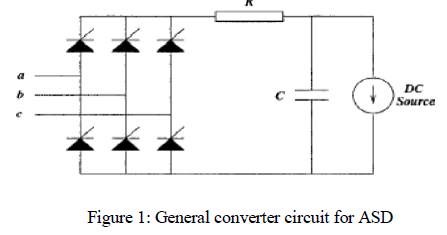 |
| The shown in figure 1 is the basic adjustable speed drive. In this drive is power electronics based design of speed control. |
DISTRIBUTED GENERATION |
| Various utilities companies currently promote the interconnection of independent alternative energy sources in the distribution network. The insertion of DG into the distribution system could either have a positive or negative impacted characteristics DG and the distribution system. Distributed Generation can be favorable if it meets the basic requirements of the system’s operating philosophy and feeder design. Some recent studies have examined the impact of DG on a system’s power quality. It was found that the effect of DG on power quality depends on the type of Distributed Generation, its interfaces with the main system, the value of DG unit, the total size of the DG relative to the system, the size of DG relative to a load at the connecting point, and feeder voltage regulation practice. |
| Having DG connected to a distribution network may provide to harmonic distortion in the system, depending on the interconnection on the various type of DG and the converter technology. In terms of DG interfacing, DGs dived into two types, namely inverter based Distributed Generation and non-inverter based Distributed Generation. Examples of inverter based DG are PV systems, wind generations, fuel cells, and micro turbines, which use converters as interfacing devices to the distribution system. On the other hand, small hydro generation and induction generators are considered to be non-inverter based Distributed Generation [13]. |
| The DGs need to be placed at the distribution system level of the electrical grid and located close to the load centre. The impact of Distributed Generation on energy losses, voltage profile, short circuit current, harmonics and power system reliable are usually tested separately before connecting it to the distribution system. The achievement of the benefits from DGs depends greatly on how correctly they are installed [14]. |
DESIGN OF DISTRIBUTED WIND GENERATION |
| Synchronous machine block used here is a built-in model of MATLAB/SIMULINK present in the Simpower systems of Simulink Library. It is operated in either electrical generator or electrical motor mode. The mode of operation is sincerely by the sign of the mechanical torque: If Tm is +ve, the machine acts as a motor. If Tm is -ve, the machine acts as a generator. Electrical part of machine is represented by a fourth-order state-space model and the mechanical part by a second-order control system. All control variables and parameters are referred by stator. That is indicated by the prime signs in the machine equations given follow. The Stator and rotor quantities are in the arbitrary two-axis reference frame (dq frame) theory [15]. |
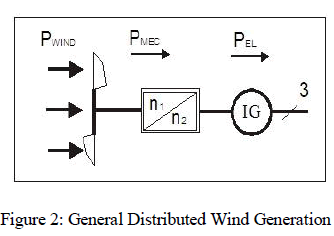 |
IEEE 13-BUS BALANCED DISTRIBUTION SYSTEM |
| IEEE 13-bus distribution system feeding different types of industrial and commercial loads show in Figure .3: is considered for harmonics analysis. The system transformer and feeder data are given in Table I and Table II. The system is fed from a main supply at 69 kV at bus 4 and a local generator of 13.8 kV operating at bus 1. A power factor rated of 6000 kVAr capacitor is connected at the point of common coupling (PCC) at bus no 3. The harmonic producing load is the adjustable speed drives of 20 hp each are serving the customers at bus 7 and bus 10. |
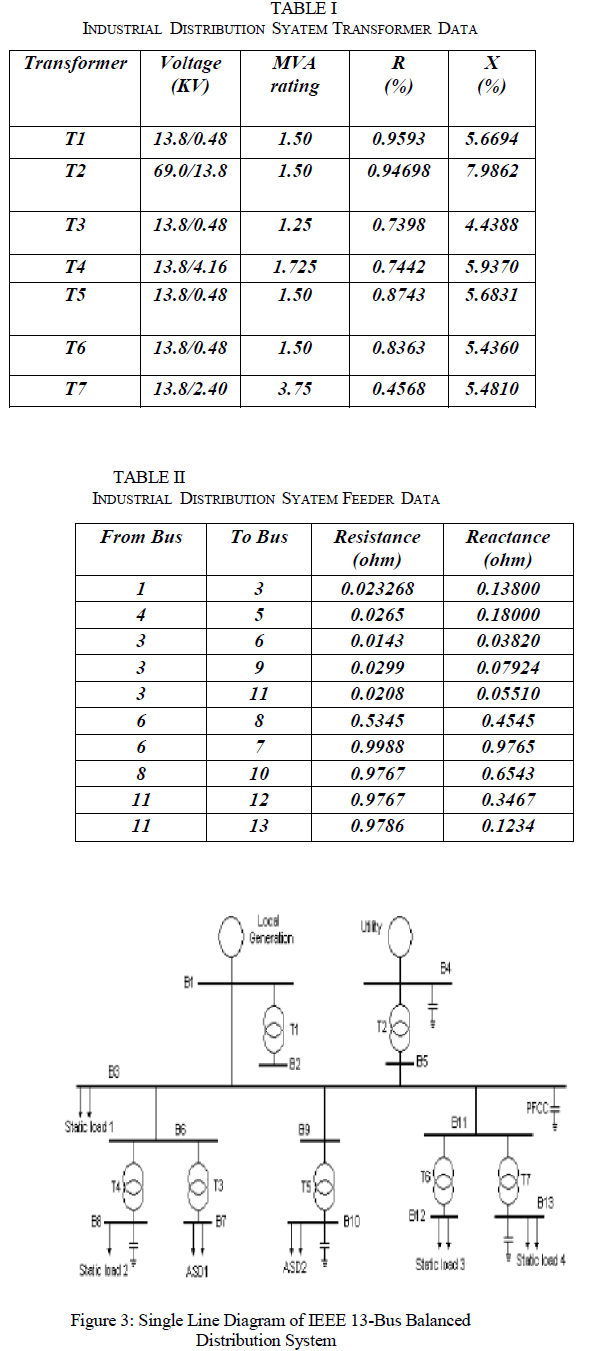 |
SIMULINK MODEL OF TEST SYSTEM |
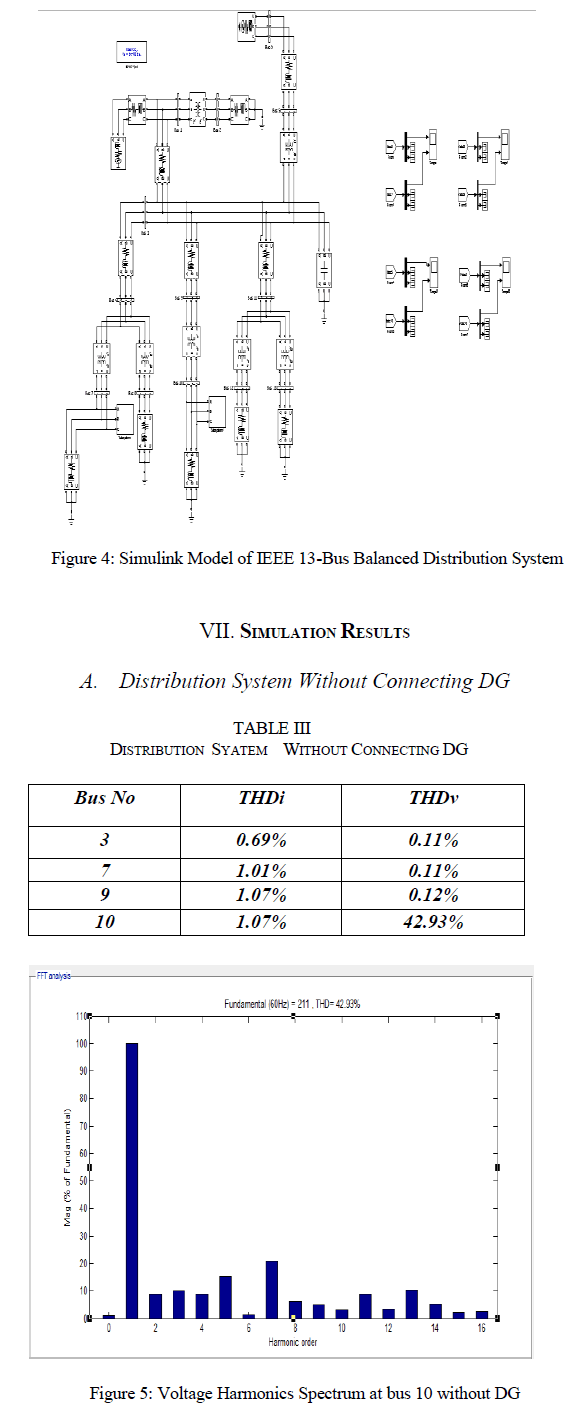 |
| B. Distribution System with Connecting One DG |
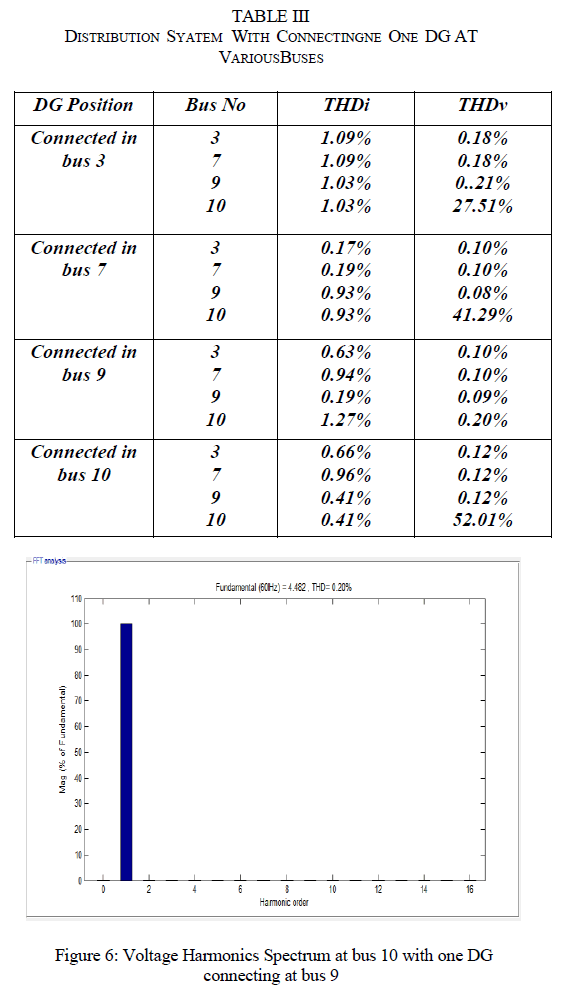 |
| C. Distribution System with Connecting One DG |
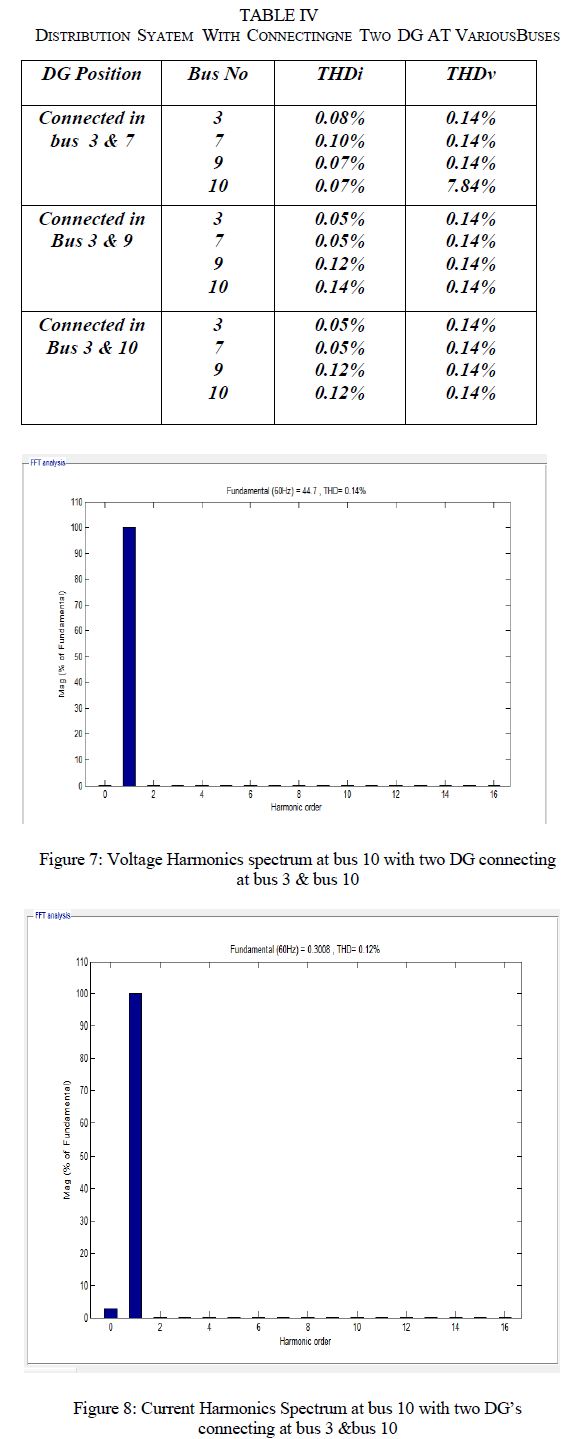 |
CONCLUSION |
| In this work, a method for placement for a DG in IEEE 13-bus balanced distribution system for estimation and mitigation of harmonics presented. Wind Generation is used as DG connected to do this operation. When wind DG connected in 9th bus voltage and current harmonics is reduced. If two DG are connected at bus 3 & 9 or 3 & 10 it is found that the voltage and current harmonics reduced. The size of wind generation is 0.5 MW. The result simulated in MATLAB/SIMULINK and gives successful implementation of DG for reducing Harmonics. |
ACKNOWLEDGMENT |
| Hereby, I thank our principal Dr.A.V.RAMPRASAD, for this kind co-operation and keen interest by which our project phase-I end in no vain. We are highly indebted and grateful to Dr.S.M.KANNAN, professor and Head of the electrical and electronics department whose kind co-operation and valuable suggestion helped us in finishing this project successfully. We also thank our guide Mr. M.JEGADEESAN, Associate Professor for his untiring efforts and guiding in bringing out this project in successful manner. I would like to express my heart full thanks to my project coordinator Dr. S.VENKATESAN, professor for valuable guidance and suggestions and in rightful comments. I also wish to extend our gratitude to our parents, all the staff members of the department of electrical and electronics engineering and our friends who have give this inspiration and active assistance to our project. |
References |
|